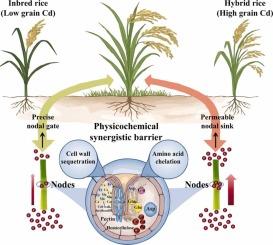Genotype-dependent fortification of rice nodes dictates cadmium fate in grains: A synergistic barrier forged from cell wall and amino acid chelation
IF 11.3
1区 环境科学与生态学
Q1 ENGINEERING, ENVIRONMENTAL
引用次数: 0
Abstract
Cadmium (Cd) accumulation in rice grains is critical for food safety, and nodes function as the central hub regulating Cd translocation to grains. However, the mechanisms for nodal Cd retention and the physiological basis for genotypic variation in this capacity remain unclear. This study investigated the nodal physicochemical characteristics of 11 genotypes (four inbred and seven hybrid) grown in Cd-contaminated fields. Nodes were identified as predominant organs of Cd sequestration in shoots, showing Cd concentrations 9.14–57.55 times higher than in internodes. Such a high retention is attributed to a "physicochemical synergistic barrier." Physically, Cd is sequestered in robust cell walls rich in pectin, hemicellulose, and dense functional groups. Chemically, nodes contain elevated levels of proteins and amino acids (notably aspartate and glutamate), forming an intracellular chemical barrier. Crucially, the efficacy of the barrier is genotype-dependent: in inbred rice, it functions as the rate-limiting step for Cd translocation, whereas in hybrid rice, the barrier is less restrictive despite substantial Cd sequestration. This study establishes the nodal physicochemical barrier as the core Cd retention mechanism, demonstrating that its genotype-dependent efficacy significantly contributes to the differences in grain Cd accumulation. Consequently, this research provides novel physiological targets for breeding low-Cd rice varieties.

水稻节点的基因型依赖性强化决定了镉在籽粒中的命运:细胞壁和氨基酸螯合形成的协同屏障
水稻籽粒中镉(Cd)的积累对食品安全至关重要,而水稻节点是镉向籽粒转运的中心枢纽。然而,节点Cd保留的机制和这种能力基因型变异的生理基础仍不清楚。研究了cd污染田中11个基因型(4个自交系和7个杂交系)的节点理化特性。茎节是吸收Cd的主要器官,Cd浓度是茎节间的9.14 ~ 57.55倍。如此高的保留率归因于“物理化学协同屏障”。物理上,镉被隔离在富含果胶、半纤维素和密集官能团的坚固细胞壁中。从化学上讲,淋巴结含有较高水平的蛋白质和氨基酸(特别是天冬氨酸和谷氨酸),形成细胞内的化学屏障。至关重要的是,屏障的效力是基因型依赖的:在自交系水稻中,它作为Cd转运的限速步骤,而在杂交水稻中,尽管大量的Cd封存,屏障的限制性较小。本研究建立了节点物理化学屏障作为Cd保持的核心机制,表明其基因型依赖效应显著地影响了籽粒Cd积累的差异。因此,本研究为低镉水稻品种的选育提供了新的生理靶点。
本文章由计算机程序翻译,如有差异,请以英文原文为准。
求助全文
约1分钟内获得全文
求助全文
来源期刊

Journal of Hazardous Materials
工程技术-工程:环境
CiteScore
25.40
自引率
5.90%
发文量
3059
审稿时长
58 days
期刊介绍:
The Journal of Hazardous Materials serves as a global platform for promoting cutting-edge research in the field of Environmental Science and Engineering. Our publication features a wide range of articles, including full-length research papers, review articles, and perspectives, with the aim of enhancing our understanding of the dangers and risks associated with various materials concerning public health and the environment. It is important to note that the term "environmental contaminants" refers specifically to substances that pose hazardous effects through contamination, while excluding those that do not have such impacts on the environment or human health. Moreover, we emphasize the distinction between wastes and hazardous materials in order to provide further clarity on the scope of the journal. We have a keen interest in exploring specific compounds and microbial agents that have adverse effects on the environment.
 求助内容:
求助内容: 应助结果提醒方式:
应助结果提醒方式:


